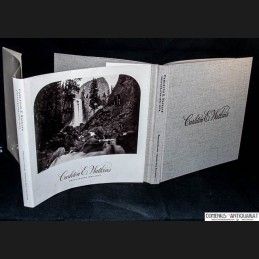Watkins, Carleton E.,
Photographs, 1861-1874. San Francisco: Fraenkel Gallery in association with Bedford Arts, 1989. VII, 219 Seiten mit Abbildungen und Literaturverzeichnis. Leinen mit Schutzumschlag. 4to. 286 x 288 mm. 1811 g
* Essay by Peter E Palmquist.
Bestell-Nr.158571 | ISBN: 0-938491-27-X
Watkins |
XIX Jahrhundert |
Nordamerika |
Photographie |
Fotografie
III LASER FULTONE4 REPRODUCTIONS
CARLETON E. WATKINS
PHOTOGRAPHS 18611874
with an introduction by Jeffrey Fraenkel and an essay by Peter E. Palmquist
"The large-scale photographs of Carleton E. Watkins are among the great achievements of American photography. They document the Western Territories at a pivotal moment in the nation's development, and do so with a passion and authority that /aid the foundation* a century of landscape photography to follow These early pictures are rich with the sense of discovery—not only of the extraordinary places they describe but of the pictorial possibilities of the medium itself' —From the introduction
Carleton E. Watkins (1829-1916) is best remembered for his mammothplate photographs of Yosemite-Valley and the Pacific Coast. This volume presents more than too images made by Watkins in his travels through California, Oregon, and Utah during the years 1861-1874. These years, which mark the birth and maturation of Watkins's vision, also define the first golden age of American landscape photography. Many of the photographs in Carleton E. Watkins: Photographs 1861-1874 have only recently come to light and are being published here for the first time. The most advanced forms of laser technology have been used in this book to reproduce the delicate tonalities and extraordinary detail of Watkins's albumen prints. Watkins brought the same sensitivity to his photographs of early Western industry and architecture that he brought to the subtleties of earth, stone, water, trees, and their encompassing light.
Peter E. Palmquist describes the difficulties under which Watkins worked: "In the summer the sun warped and shrank camera parts and plate holders. Watkins's darktent was almost unbearably hot.... He frequently worked in the predawn light, with exposures lasting as long as one hour, to avoid the wind and to take advantage of the morning coolness. Under these conditions, Watkins counted it a good day indeed when he was able to complete as many as four large negatives!' "If this business don't give us a living we will go and squat on some government land and raise spuds!" So wrote Watkins to his young wife Frankie in 1880. His letters to Frankie let us glimpse financial ruin and personal loss set against the grandeur of the landscapes he explored. Watkins's photographs reveal both his feeling for the materials of the earth and his pleasure in the act of seeing. As the introduction states: "The respect with which Watkins approached his subjects and the underlying spirit that informed his sensibility have a strength and relevance that can shape the way one views the world:'
JEFFREY FRAENKEL founded Fraenkel Gallery in San Francisco in 1979 with an exhibition of photographs by Carleton E. Watkins. The gallery exhibits and publishes work spanning the entire history of photography.
PETER E.. PALMQUIST is a writer, historian, and photographer living in northern California. He is the author of Carleton E. Watkins: Photographer of the American West (University of New Mexico Press for The Amon Carter Museum, 1983).
FRAENKEL GALLERY IN ASSOCIATION WITH BEDFORD ARTS, PUBLISHERS SAN FRANCISCO
ISBN 093849127X
COVER Piwyac, Vernal Fall, Soo ft., Yosemite 1861






 Fermé temporairement
Fermé temporairement
